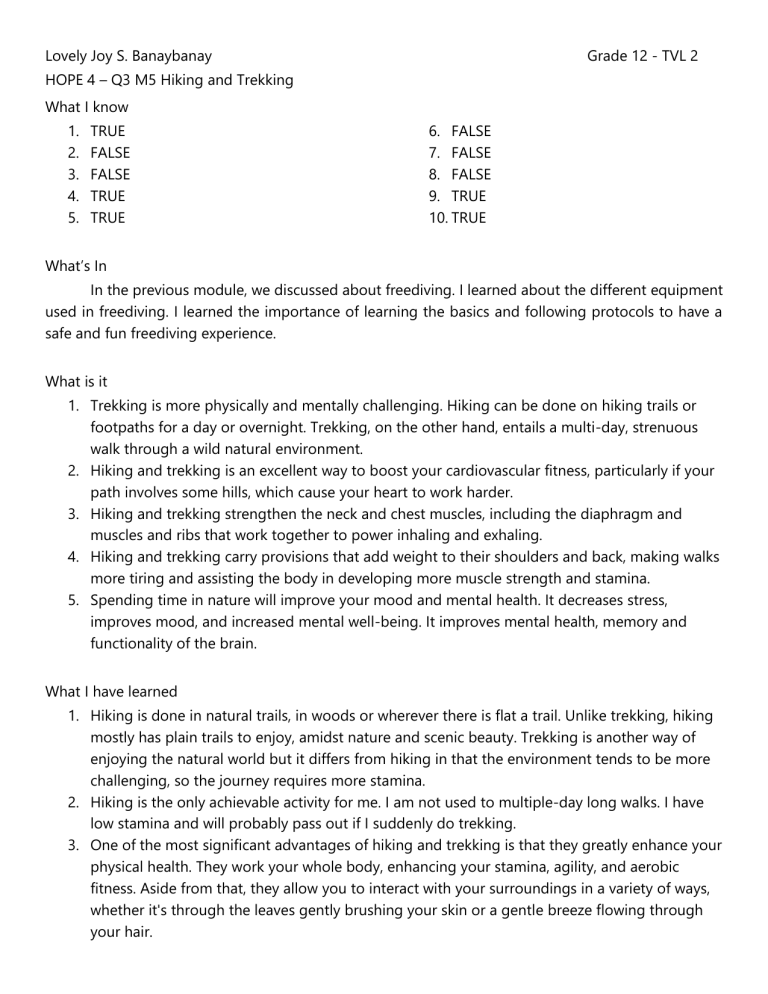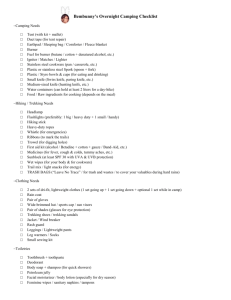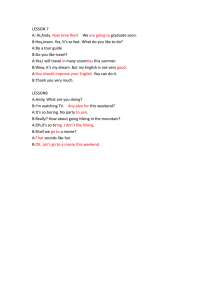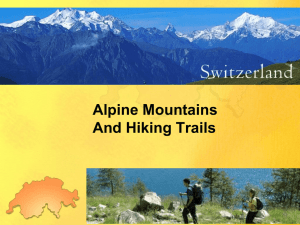
Lovely Joy S. Banaybanay Grade 12 - TVL 2 HOPE 4 – Q3 M5 Hiking and Trekking What I know 1. 2. 3. 4. 5. TRUE FALSE FALSE TRUE TRUE 6. FALSE 7. FALSE 8. FALSE 9. TRUE 10. TRUE What’s In In the previous module, we discussed about freediving. I learned about the different equipment used in freediving. I learned the importance of learning the basics and following protocols to have a safe and fun freediving experience. What is it 1. Trekking is more physically and mentally challenging. Hiking can be done on hiking trails or footpaths for a day or overnight. Trekking, on the other hand, entails a multi-day, strenuous walk through a wild natural environment. 2. Hiking and trekking is an excellent way to boost your cardiovascular fitness, particularly if your path involves some hills, which cause your heart to work harder. 3. Hiking and trekking strengthen the neck and chest muscles, including the diaphragm and muscles and ribs that work together to power inhaling and exhaling. 4. Hiking and trekking carry provisions that add weight to their shoulders and back, making walks more tiring and assisting the body in developing more muscle strength and stamina. 5. Spending time in nature will improve your mood and mental health. It decreases stress, improves mood, and increased mental well-being. It improves mental health, memory and functionality of the brain. What I have learned 1. Hiking is done in natural trails, in woods or wherever there is flat a trail. Unlike trekking, hiking mostly has plain trails to enjoy, amidst nature and scenic beauty. Trekking is another way of enjoying the natural world but it differs from hiking in that the environment tends to be more challenging, so the journey requires more stamina. 2. Hiking is the only achievable activity for me. I am not used to multiple-day long walks. I have low stamina and will probably pass out if I suddenly do trekking. 3. One of the most significant advantages of hiking and trekking is that they greatly enhance your physical health. They work your whole body, enhancing your stamina, agility, and aerobic fitness. Aside from that, they allow you to interact with your surroundings in a variety of ways, whether it's through the leaves gently brushing your skin or a gentle breeze flowing through your hair. 4. I think lack of self-discipline, lack of time, and lack of interest are the most significant perceived barriers in performing hiking and trekking. To overcome them, one must know how to focus on the objective, manage time, and look for a motivation. What I can Do Activities Ratings 1. HIKING 12-13 2. TREKKING 19-20 1. I realize I am weak. I lack exercise due to being stuck at home for a long time. I am also now used to getting a lot of sleep which put a toll on my stamina. 2. I lack time, interest, discipline and the skill. I have to manage my time, look for an inspiration, be focused and start learning more. Assessment 1. C 2. C 3. D 4. D 5. D Additional Activity Before going, we must know where to go, and tell someone what the route is and when we are expected to return back to our car or in cell phone range. We must have a good understanding of our own level of fitness, experience, and confidence to make the hike more enjoyable and safe. We must plan for what trail conditions to avoid, and know in advance when it might be a good idea to turn back. Don’t deviate from the path and make sure you save emergency numbers in at least 2 people’s phones. Plan to hike together - Never ever hike alone. Always go prepared for severe weather, i.e. take proper weatherproof clothing even on a sunny day (wind and rainproof). Must bring enough food and water (Take 2L per person), as well as first aid kit. It is good to bring water filtration system or purification tablets. Always remember to stay hydrated. Lovely Joy S. Banaybanay Grade 12 - TVL 2 HOPE 4 – Q3 M6 Rock Climbing What I know 1. 2. 3. 4. 5. TRUE TRUE FALSE TRUE TRUE 6. FALSE 7. TRUE 8. TRUE 9. FALSE 10. TRUE What’s In The topic we discussed in the previous module is hiking and trekking. I enjoyed researching about hiking and trekking. I learned difference between the two and the safety precautions that must be done while doing them. They are important to learn because we can do hiking and trekking for fun or for what might happen in the future that will require us to do something similar to hiking and trekking. The skills learned from this can be used for survival if lost in a forest. What is it 1. My barriers are lack of time, lack of energy, and lack of resources. 2. Yes, overcoming them will make me active and physically fit. What’s More Cardiovascular fitness 1. running. 2. power walking. 3. jump rope. Flexibility 1. stretching. 2. yoga. 3. tai chi. Muscular endurance and muscular strength 1. lifting weights. 2. working with resistance bands. 3. climbing stairs. What I have learned 1. Rock climbing is a sport in which competitors climb up, down, or over natural or man-made rock formations or rock walls. The objective is to reach the top of a formation or the endpoint of a predefined route without falling. Climbing promotes the development of lean, endurance muscles. It strengthens core muscles more effectively than exercise routines that target that area. The core stabilizes the body, making it stronger and less vulnerable to injury. Climbing benefits the entire body, including your cardiovascular system. 2. I think I will be able to do bouldering. I used to climb to the roof with my cousins when I was a kid. I was pretty good at looking for crevices and bumps to step and hold on to. I still remember how to do it. 3. Rock climbing is a difficult sport and can be dangerous when not done right. Thus, the participants must exert a lot of physical and mental effort. The barrier this statement might cause can be fear of injury and lack of confidence. However, if done right and with the support of others, this can be easily overcome. 4. My barriers are lack of time, lack of energy, and lack of resources. I can overcome them by managing my time, do exercise to improve my stamina and look for cheaper but safe options. What I can do Very likely 1. 2. 3. 4. 5. 6. 7. 8. 9. 10. Somewhat likely Somewhat unlike Very unlikely ✓ ✓ ✓ ✓ ✓ ✓ ✓ ✓ ✓ 11. 12. 13. 14. 15. 16. 17. 18. 19. 20. 21. ✓ ✓ ✓ ✓ ✓ ✓ ✓ ✓ ✓ ✓ ✓ ✓ + 4 3 4 4 1 1 4 + 4 3 4 1 2 1 4 4 4 4 4 1 2 4 total 12 10 12 9 4 4 12 Barrier Lack of time Social influence Lack of energy Lack of willpower Fear of injury Lack of skill Lack of resources 1. My barriers are lack of time, social influence, lack of energy, lack of willpower, and lack of resources. I plan to manage my time, ask family to support me, exercise more, find a motivation and look for alternatives. Assessment 1. FALSE - Harness - CLIMBING ROPE 7. FALSE - belay device - CARABINERS 2. TRUE 8. TRUE 3. TRUE 9. TRUE 4. FALSE - climbing ropes - HELMET 10. FALSE - environmental barriers PERSONAL BARRIER 5. TRUE 6. FALSE - lead - BELAYER Additional activity Are your fit enough to perform this activity? YES Rate (from the Rate of Perceived Exertion): 12 (SOMEWHAT HARD) From your rating alone, explain why did you choose it: - I am able to do this but will require some effort to build up my strength and stamina first.



